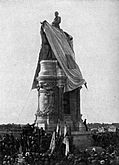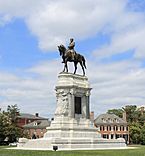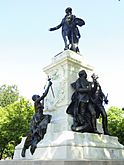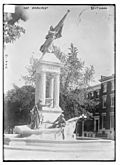Antonin Mercié facts for kids
Antonin Mercié (born October 30, 1845, in Toulouse, France – died December 12, 1916, in Paris) was a famous French artist. He was known for making sculptures, medals, and paintings.
His Life as an Artist
Antonin Mercié went to the École des Beaux-Arts in Paris. This was a famous art school. He learned from well-known sculptors like Alexandre Falguière and François Jouffroy.
In 1868, when he was 23, Mercié won the Grand Prix de Rome. This was a very important prize for young artists. Winning it meant he could study art in Rome, Italy, for several years.
His first big successes were two sculptures: David and Gloria Victis. Gloria Victis means "Glory to the Vanquished" (those who were defeated). This sculpture won a special medal at the Paris Salon. The Paris Salon was a huge art show in France.
The bronze statue of David became one of his most popular works. Many copies were made. The original life-sized statue is now in the Musée d'Orsay in Paris.
Mercié later became a professor at the École des Beaux-Arts. He taught drawing and sculpture. In 1891, he was chosen to be a member of the Académie française. This is a very respected group of important French figures. He also became the president of the Société des artistes français in 1913. This was a society for French artists.
Antonin Mercié passed away in Paris on December 12, 1916.
Famous Sculptures and Artworks
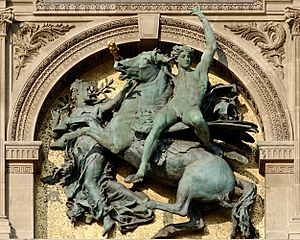
Mercié created many important artworks. One of his sculptures is The Genius of the Arts (1877). This artwork is a relief, which means it sticks out from a flat surface. You can see it in the Tuileries Garden in Paris.
He also designed a monument for the tomb of Jules Michelet (1879). This is in the Père Lachaise Cemetery in Paris. In the same year, he made a statue of Arago for the city of Perpignan.
In 1882, he made another patriotic sculpture called Quand Même! (meaning "Even So!"). Copies of this work are in Belfort and the Tuileries Garden.
Le Souvenir (1885) is a beautiful marble statue. It was made for the tomb of Charles Ferry. Another work, Regret, was made in 1892 for the tomb of Alexandre Cabanel. He also created a statue of William Tell in 1892, which is now in Lausanne.
Mercié designed monuments for other famous people too. These include Jean-Louis-Ernest Meissonier (1895) in the Louvre and Louis Faidherbe (1896) in Lille. He also made a statue of Adolphe Thiers and monuments for Louis-Philippe and Queen Amélie. His stone group of Justice is at the Hôtel de Ville in Paris.
Mercié also made many portrait busts and medallions. He won a medal at the Paris Exhibition in 1878 and a grand prize in 1889 for his sculptures.
Besides sculptures, Mercié was also a painter. Some of his paintings include a Venus (1883), Leda (1884), and Michelangelo studying Anatomy (1885).
In the United States, Mercié is known for three monuments. One was the 1890 Robert E. Lee equestrian bronze in Richmond, Virginia. This monument was removed in September 2021. He also worked with his former teacher Alexandre Falguière on the statue of the Marquis de Lafayette in Lafayette Square, Washington, D.C. (1891). Lastly, he created the 1911 Francis Scott Key Monument in Baltimore, Maryland.
Gallery
-
Statue of the Marquis de Lafayette, Lafayette Square, Washington, D.C., 1891
See also
 In Spanish: Antonin Mercié para niños
In Spanish: Antonin Mercié para niños
- List of works by Antonin Mercié






